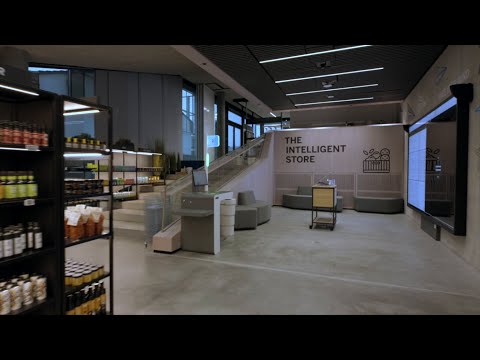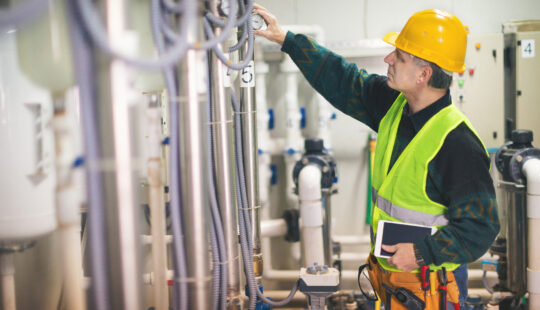“Did you find everything you were looking for?” This is the question the most attentive sales floor associate will ask customers before they exit a store. If the response is “Yes, thank you!” then everyone’s experience ends on a happy note.
But what happens when the answer is “No, actually, I didn’t. You were all out.”? You cannot teleport out-of-stock item onto the shelf for the customer’s experience to be made whole immediately.
Create one too many of these unfortunate experiences, and the customer is apt to move their shopping elsewhere, where the experience is smoother and more rewarding.
Future of Retail Technology at Brick-and-Mortar Stores
The customer friction can be costly. But problems like stockouts and long lines — and the customer friction they beget — are promising to become a thing of the past for retailers that adopt the most recent innovations in machine learning, artificial intelligence (AI), and the Internet of Things (IoT).
With smart technologies like touchless shopping and automated on-shelf forecasting, customers are delighted with a frictionless in-store experience that resembles the ease of online shopping. Innovative intelligent stores, or “smart stores,” are popping up everywhere.
S.MART Pulls Back the Curtain with an Immersive Retail Journey
Enter the future of retail: At the SAP Experience Center location in Walldorf, Germany, curious minds can step into the intelligent store “S.MART” for a journey into an innovative, sustainable retail enterprise in action.
With centers across the globe, SAP Experience Center locations are state-of-the-art innovation spaces for reimagining business using SAP solutions.
In October 2022, the SAP Experience Center in Walldorf will officially open its doors, which will be the first of many milestones to come on an ongoing transformation journey toward an even more captivating exploration into SAP innovation worldwide.
The S.MART component provides a taste of all the available uses cases of SAP’s retail technology ecosystem in one immersive grocery store experience. Peruse the aisles as a customer while simultaneously seeing how various types of data are captured in the back office, in order to gain insights into the shopping behaviors and interests of customers, more sustainable business practices, improved product performance, and more efficient staffing.
To kick-start their own transformations, retailers can request a customized visit, where the SAP Experience Center is set up as a secure testing environment for use cases specific to their business needs.
How Digital Transformation Solves 10 Traditional Retail Challenges
The value of building a store like S.MART goes beyond keeping shelves nicely stocked. Here are 10 common challenges retailers experience and how digital transformation through an intelligent store can solve them.
1. Respond to customer expectations of personalized and immersive experiences
Personalized loyalty programs in-store and online offer customers the discounts and rewards they appreciate and are likely to use. SAP solutions allow for businesses in the tech ecosystem to effectively create products like augmented reality (AR) on mobile shopping. AR technology enables personalized experiences by turning a two-dimensional search into a full-fledged 3D immersion. The camera on the consumer’s device scans their real-world surroundings and mirrors the product in that environment. That way, consumers can virtually try before they buy. Learn more about how SAP supports AR technology like Adloid here. These types of customer-centric tools can help ensure that you are responding to customer expectations of streamlined, digital experiences and keep them coming back for more.
2. Optimize product placement
Heatmapping allows for visualizing visitor traffic, while camera streams and 3D vision sensors give demographic and soft biometric details like time of day, age, gender, and time spent at locations. Armed with this data, you can identify heavily trafficked areas and patterns in customer behavior, so you can better strategize product placement and limited time offers.
3. Prevent stockouts
Demand forecasting helps prevent shelves from going bare. Out-of-stock items, or stockouts, are caused by one or a cluster of causes: unusually higher demand, supply chain disruptions, inventory miscounts, and improper planning.
Forecasting technology helps to deter those challenges. Additionally, with technology apps that maintain one consistent source of stock information across the supply chain, you can maintain a more accurate record of goods and further boost forecasting efforts. With the latest AI, you can more effectively keep your shelves stocked, and avoid lost sales.
4. Keep shelves tidy
Today’s customers expect stores to look tidy and organized. AI connected to video cameras can interpret if a product is misplaced, while sensor-based technology identifies if a shelf is empty. Store personnel are alerted so they can act immediately and keep the shelves pristine.
5. Make the most out of limited storage space
Deep learning and machine learning applied by AI surfaces actionable insights related to customer behavior and supply chain fluctuations, enabling for improved forecasting and more accurate inventory decisions.
With automated sub-daily demand forecasting, you order what your customers are likely to buy at a particular time of day — no more, no less, making the most out of your shelf and storage space and delivering what customers want when they want it.
6. Reduce food spoilage
According to a recent study, “Along the food chain, approximately 15% of food losses by weight and value derive from transport, warehouse, and retailing activities. However, for a variety of reasons, temperature abuse and improper handling in transport seems to dominate.”
An effective way to make a dent in that problem is by using smart technology to improve cold storage issues throughout the supply chain, from packing to marketing. At the retail location, as soon as freezers are open past a set period or there is a deviation in the temperature of the products, an alarm is triggered to alert store personnel to address the problem.
7. Become a more sustainable enterprise
Historically, retail companies are a major contributor of carbon emissions and waste, putting them under the scrutiny of consumers and regulators. With demonstrable sustainability practices, retailers can successfully differentiate their brands, attract new customers, and drive life-long loyalty. By harnessing the power of AI, you can perform accurate and responsive planning, thereby optimizing the flow of goods to reduce emissions, overstocks, and food waste.
8. Minimize annoying checkout lines
We have come far from long checkout lines, noisy cash registers, and paper receipts. Customers can simply add products to their virtual baskets and leave the store without any wait time at the point of sale. As noted, today’s consumers are digitally savvy shoppers who expect retailers to provide a streamlined experience in-store and online. “Just walk out” experiences help recreate the simplicity and ease of shopping online.
9. Comply with maximum occupancy limits
When it is important to know that maximum capacities are not exceeded, and costly fines are avoided, you don’t need a person standing at the door with a tally counter in hand. Automated analysis of all persons entering and exiting the store are kept in real time, and store personnel is notified when maximum capacity is reached. Plus, with historical data, you can plan staffing needs accordingly.
10. Motivate employees
Machine learning and AI technologies from SAP can serve to reduce friction points in the workforce. For example, insights into the busiest times and store sections can inform optimized staff schedules, reducing stress burnout. Automated alerts regarding empty shelves and improper product placement can help simplify an employee’s workday, thereby increasing engagement. And streamlined forecasting and replenishment processes replace cumbersome and inaccurate manual efforts, enabling store associates to be more efficient and successful in their inventory keeping responsibilities.
With intelligent features that foster a future-forward work environment, employees are more empowered, productive, and happier. And at the end of the day, a happy workforce thrives on serving happy customers.

Markus Marsch, head of Value Experience Strategy and Operations, explains how retail experiences like S.MART are the future of retail.
More Inspiration on the Way
SAP Experience Center locations around the world showcase innovative solutions and use cases for all industries and lines of business. We are creating more of these experiences — like an SAP-driven retail fashion studio in New York and a smart cities experience in Dubai — to showcase how SAP builds the innovative solutions that run the world’s most intelligent and sustainable enterprises.
SAP Experience Centers connect businesses to SAP solution experts, inspire transformation through innovative demos and immersive stories, and engage enterprise transformation through hands-on workshops.
Top image: The S.MART intelligent store at the SAP Experience Center in Walldorf, Germany, officially opens in October 2022. Visitors can peruse grocery store aisles like a customer then get back-office analysis in real time.



